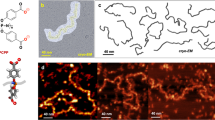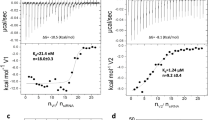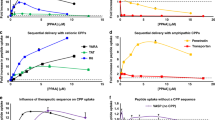Abstract
Virus-like particles (VLPs) have emerged as important and versatile architectures for chemical manipulation in the development of functional hybrid nanostructures. Here we demonstrate a successful site-selective initiation of atom-transfer radical polymerization reactions to form an addressable polymer constrained within the interior cavity of a VLP. Potentially, this protein–polymer hybrid of P22 and cross-linked poly(2-aminoethyl methacrylate) could be useful as a new high-density delivery vehicle for the encapsulation and delivery of small-molecule cargos. In particular, the encapsulated polymer can act as a scaffold for the attachment of small functional molecules, such as fluorescein dye or the magnetic resonance imaging (MRI) contrast agent Gd-diethylenetriaminepentacetate, through reactions with its pendant primary amine groups. Using this approach, a significant increase in the labelling density of the VLP, compared to that of previous modifications of VLPs, can be achieved. These results highlight the use of multimeric protein–polymer conjugates for their potential utility in the development of VLP-based MRI contrast agents with the possibility of loading other cargos.
This is a preview of subscription content, access via your institution
Access options
Subscribe to this journal
Receive 12 print issues and online access
$259.00 per year
only $21.58 per issue
Buy this article
- Purchase on Springer Link
- Instant access to full article PDF
Prices may be subject to local taxes which are calculated during checkout







Similar content being viewed by others
References
Grover, G. N. & Maynard, H. D. Protein–polymer conjugates: synthetic approaches by controlled radical polymerizations and interesting applications. Curr. Opin. Chem. Biol. 14, 818–827 (2010).
Krishna, O. D. & Kiick, K. L. Protein- and peptide-modified synthetic polymeric biomaterials. Biopolymers 94, 32–48 (2010).
Thordarson, P., Le Droumaguet, B. & Velonia, K. Well-defined protein–polymer conjugates – synthesis and potential applications. Appl. Microbiol. Biotechnol. 73, 243–254 (2006).
Depp, V., Alikhani, A., Grammer, V. & Lele, B. S. Native protein-initiated ATRP: a viable and potentially superior alternative to PEGylation for stabilizing biologics. Acta Biomater. 5, 560–569 (2009).
Klok, H. A. Peptide/protein-synthetic polymer conjugates: quo vadis. Macromolecules 42, 7990–8000 (2009).
Pokorski, J. K., Breitenkamp, K., Liepold, L. O., Qazi, S. & Finn, M. G. Functional virus-based polymer–protein nanoparticles by atom transfer radical polymerization. J. Am. Chem. Soc. 133, 9242–9245 (2011).
Schlick, T. L., Ding, Z. B., Kovacs, E. W. & Francis, M. B. Dual-surface modification of the tobacco mosaic virus. J. Am. Chem. Soc. 127, 3718–3723 (2005).
de la Escosura, A., Nolte, R. J. M. & Cornelissen, J. Viruses and protein cages as nanocontainers and nanoreactors. J. Mater. Chem. 19, 2274–2278 (2009).
Aniagyei, S. E., DuFort, C., Kao, C. C. & Dragnea, B. Self-assembly approaches to nanomaterial encapsulation in viral protein cages. J. Mater. Chem. 18, 3763–3774 (2008).
Dixit, S. K. et al. Quantum dot encapsulation in viral capsids. Nano Lett. 6, 1993–1999 (2006).
Comellas-Aragones, M. et al. Controlled integration of polymers into viral capsids. Biomacromolecules 10, 3141–3147 (2009).
Douglas, T. & Young, M. Host–guest encapsulation of materials by assembled virus protein cages. Nature 393, 152–155 (1998).
Hu, Y. F., Zandi, R., Anavitarte, A., Knobler, C. M. & Gelbart, W. M. Packaging of a polymer by a viral capsid: the interplay between polymer length and capsid size. Biophys. J. 94, 1428–1436 (2008).
Abe, S. et al. Polymerization of phenylacetylene by rhodium complexes within a discrete space of apo-ferritin. J. Am. Chem. Soc. 131, 6958–6960 (2009).
Abedin, M. J., Liepold, L., Suci, P., Young, M. & Douglas, T. Synthesis of a cross-linked branched polymer network in the interior of a protein cage. J. Am. Chem. Soc. 131, 4346–4354 (2009).
Liepold, L. O. et al. Supramolecular protein cage composite MR contrast agents with extremely efficient relaxivity properties. Nano Lett. 9, 4520–4526 (2009).
Lucon, J. et al. A click chemistry based coordination polymer inside small heat shock protein. Chem. Commun. 46, 264–266 (2010).
Earnshaw, W., Casjens, S. & Harrison, S. C. Assembly of head of bacteriophage P22: X-ray diffraction from heads, proheads and related structures. J. Mol. Biol. 104, 387–410 (1976).
Parent, K. N. et al. P22 coat protein structures reveal a novel mechanism for capsid maturation: stability without auxiliary proteins or chemical crosslinks. Structure 18, 390–401 (2010).
Teschke, C. M., McGough, A. & Thuman-Commike, P. A. Penton release from P22 heat-expanded capsids suggests importance of stabilizing penton–hexon interactions during capsid maturation. Biophys J 84, 2585–2592 (2003).
Chen, D. H. et al. Structural basis for scaffolding-mediated assembly and maturation of a dsDNA virus. Proc. Natl Acad. Sci. USA 108, 1355–1360 (2011).
Kang, S. et al. Implementation of P22 viral capsids as nanoplatforms. Biomacromolecules 11, 2804–2809 (2010).
Tuma, R., Prevelige, P. E. & Thomas, G. J. Mechanism of capsid maturation in a double-stranded DNA virus. Proc. Natl Acad. Sci. USA 95, 9885–9890 (1998).
Mantovani, G. et al. Design and synthesis of N-maleimido-functionalized hydrophilic polymers via copper-mediated living radical polymerization: a suitable alternative to PEGylation chemistry. J. Am. Chem. Soc. 127, 2966–2973 (2005).
Heredia, K. L. et al. In situ preparation of protein: ‘Smart’ polymer conjugates with retention of bioactivity. J. Am. Chem. Soc. 127, 16955–16960 (2005).
Peeler, J. C. et al. Genetically encoded initiator for polymer growth from proteins. J. Am. Chem. Soc. 132, 13575–13577 (2010).
Alidedeoglu, A. H., York, A. W., Rosado, D. A., McCormick, C. L. & Morgan, S. E. Bioconjugation of D-glucuronic acid sodium salt to well-defined primary amine-containing homopolymers and block copolymers. J. Polym. Sci. A 48, 3052–3061 (2010).
Weinstein, J. N., Yoshikami, S., Henkart, P., Blumenthal, R. & Hagins, W. A. Liposome–cell interaction: transfer and intracellular release of a trapped fluorescent marker. Science 195, 489–492 (1977).
Chen, R. F. & Knutson, J. R. Mechanism of fluorescence concentration quenching of carboxyfluorescein in liposomes: energy transfer to nonfluorescent dimers. Anal. Biochem. 172, 61–77 (1988).
Kang, S., Hawkridge, A. M., Johnson, K. L., Muddiman, D. C. & Prevelige, P. E. Identification of subunit–subunit interactions in bacteriophage P22 procapsids by chemical cross-linking and mass spectrometry. J. Proteome Res. 5, 370–377 (2006).
Allen, M. et al. Paramagnetic viral nanoparticles as potential high-relaxivity magnetic resonance contrast agents. Magn. Reson. Med. 54, 807–812 (2005).
Liepold, L. et al. Viral capsids as MRI contrast agents. Magn. Reson. Med. 58, 871–879 (2007).
Anderson, E. A. et al. Viral nanoparticles donning a paramagnetic coat: conjugation of MRI contrast agents to the MS2 capsid. Nano Lett. 6, 1160–1164 (2006).
Prasuhn, D. E., Yeh, R. M., Obenaus, A., Manchester, M. & Finn, M. G. Viral MRI contrast agents: coordination of Gd by native virions and attachment of Gd complexes by azide–alkyne cycloaddition. Chem. Commun. 1269–1271 (2007).
Datta, A. et al. High relaxivity gadolinium hydroxypyridonate–viral capsid conjugates: nanosized MRI contrast agents. J. Am. Chem. Soc. 130, 2546–2552 (2008).
Hooker, J. M., Datta, A., Botta, M., Raymond, K. N. & Francis, M. B. Magnetic resonance contrast agents from viral capsid shells: a comparison of exterior and interior cargo strategies. Nano Lett. 7, 2207–2210 (2007).
Dunand, F. A., Borel, A. & Helm, L. Gd(III) based MRI contrast agents: improved physical meaning in a combined analysis of EPR and NMR data? Inorg. Chem. Commun. 5, 811–815 (2002).
Mulder, W. J. M., Strijkers, G. J., van Tilborg, G. A. F., Griffioen, A. W. & Nicolay, K. Lipid-based nanoparticles for contrast-enhanced MRI and molecular imaging. NMR Biomed. 19, 142–164 (2006).
Ghaghada, K. B. et al. New dual mode gadolinium nanoparticle contrast agent for magnetic resonance imaging. PLoS One 4, 1–7 (2009).
Karfeld-Sulzer, L. S., Waters, E. A., Davis, N. E., Meade, T. J. & Barron, A. E. Multivalent protein polymer MRI contrast agents: controlling relaxivity via modulation of amino acid sequence. Biomacromolecules 11, 1429–1436 (2010).
Schuhmanngiampieri, G., Schmittwillich, H., Frenzel, T., Press, W. R. & Weinmann, H. J. In vivo and in vitro evaluation of Gd-DTPA-polylysine as a macromolecular contrast agent for magnetic resonance imaging. Invest. Radiol. 26, 969–974 (1991).
Ananta, J. S. et al. Geometrical confinement of gadolinium-based contrast agents in nanoporous particles enhances T(1) contrast. Nature Nanotech. 5, 815–821 (2010).
Acknowledgements
This research was supported in part by grants from the National Institutes of Health (R01-EB012027), the National Science Foundation (CBET-0709358) and a National Science Foundation Graduate Research Fellowship (J.L.). P.E.P. and G.J.B. were supported by the US Department of Energy, Office of Basic Energy Sciences, Division of Materials Sciences and Engineering (DE-FG02-08ER46537).
Author information
Authors and Affiliations
Contributions
J.L. designed and carried out the experiments. S.Q. characterized the samples by NMR and analysed the relaxivity data. M.U. and B.L.F. assisted in the initial characterization of the S39C mutant. G.J.B. characterized the samples by analytical ultracentrifugation. M.U. and T.D. assisted in the experimental design. J.L. and T.D. co-wrote the manuscript. P.E.P. and T.D. coordinated the project. All authors discussed the results.
Corresponding author
Ethics declarations
Competing interests
The authors declare no competing financial interests.
Supplementary information
Supplementary information
Supplementary information (PDF 1314 kb)
Rights and permissions
About this article
Cite this article
Lucon, J., Qazi, S., Uchida, M. et al. Use of the interior cavity of the P22 capsid for site-specific initiation of atom-transfer radical polymerization with high-density cargo loading. Nature Chem 4, 781–788 (2012). https://doi.org/10.1038/nchem.1442
Received:
Accepted:
Published:
Issue Date:
DOI: https://doi.org/10.1038/nchem.1442
This article is cited by
-
Recent progress in targeted delivery vectors based on biomimetic nanoparticles
Signal Transduction and Targeted Therapy (2021)
-
Synthesis and applications of anisotropic nanoparticles with precisely defined dimensions
Nature Reviews Chemistry (2020)
-
Targeted delivery of 5-fluorouracil-1-acetic acid (5-FA) to cancer cells overexpressing epithelial growth factor receptor (EGFR) using virus-like nanoparticles
Scientific Reports (2020)
-
Investigation on the alternating and gradient anionic copolymerization of 4-methylenethiochromane (META) and isoprene modified with additives
Polymer Journal (2020)
-
Design and biosynthesis of functional protein nanostructures
Science China Life Sciences (2020)



